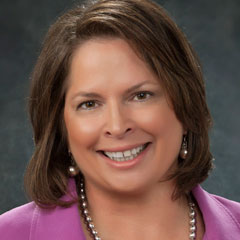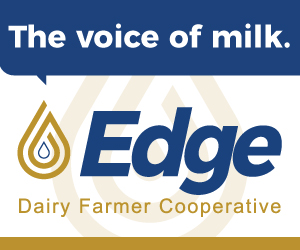This is the third episode in our five-episode podcast series on the issues facing the dairy industry sponsored by Edge Dairy Farmer Cooperative. In this episode, farm broadcasters Spencer Chase and Ben Nuelle explore the economics and the pricing practices of the industry.
To listen to the podcast, click here. To listen to episode one, click here. To listen to episode two, click here.
You can also subscribe to the podcast on iTunes, Spotify, and Google Podcasts.
Think back to the first dollar you ever made... that rigid cotton-style greenish piece of paper with folded corners sporting a portrait of George Washington staring you in the face. I’m sure it gave you a feeling of success and accomplishment. You may have received it after raking up a pile of leaves for your neighbor, mowing the lawn for mom, finishing chores, or selling the first truck of milk on your newly established dairy operation. Either way... you wanted more of it. When receiving money for work as a child, you figured out the harder you worked the more money you could earn; but as you grew older, you quickly discovered working to make that dollar is not as easy as you thought.
You learned about overhead costs. These are all the expenses it takes to earn that dollar. Things like accounting fees, advertising, insurance, interest, legal fees, labor, rent, repairs, supplies... the list goes on. There is a common mistake when working with dairy producers. Some just focus on milk production or finances but both must be understood as they work in tandem. Producers must pencil out all expenses from feed costs, transportation, and utilities to get the most out of their milk check.
In this episode, we’ll investigate that and more on Agri-Pulse Deep Dive on Dairy... Episode 3: Milk Money.
Running a dairy operation is not easy and making a profit is even harder when milk prices are low. Not only is the work labor-intensive but financially, like any business, you have to make sure everything pencils out.
Nuelle: "How long have you guys been in business?"
Bill Mueller: "We’ve been on our own for 25 years."
Meet Bill and Raynelle Mueller from Big Stone City, S.D.
I met Bill and Raynelle at World Dairy Expo.
Bill: “We’ve been on our own for 25 years. We’ve been married for 43 years with the dairy and farming.
Nuelle: A lot of ups and downs in the dairy industry the last couple of years. Talk to me about how you got through some of those challenges?
Raynelle: The year we built our barn. Kind of a tough year because we didn’t start milking until February of that year.
Ben: What year was that?
Raynelle: 1994. We had $5 corn and $8 milk. You do a lot of creative planning to make that work.
Ben: And as far as kind of comparing that to now, are you seeing similarities, differences, what is the difference between now and then?
Raynelle: Fuel prices are higher, input prices are higher for the crops. The price of milk sometimes average-wise does not always compare. It is about $8 milk and $5 corn again.
They say it is awfully challenging to make a profit these days.
Bill: You’ve got to watch every penny.
Raynelle: You almost have to put ‘how much’ across your forehead and hope somebody reads it when they drive across your yard.
I also ran into Dave Daniels at expo. He is a member-owner of Mighty Grand Dairy, a 575 dairy cow operation near Union Grove, Wisconsin.
“We put Mighty Grand Dairy together in 1997 by three neighbors getting together and consolidating. Some of the things we saw in the nineties was that we need to consolidate some of our assets because we could see that it would be beneficial for an economy of scale to do some purchasing that way and when you look at growing your crops, you’d have to have a line of machinery, that was getting more expensive so it was a really great thing to do at that point and we still continue to feel that it is good.”
He says making a profit over the next five to 10 years is going to depend on where milk prices go.
Joleen Hadrich is an associate professor in applied economics at the University of Minnesota. Before coming to the University of Minnesota, she worked at land-grant universities in North Dakota and Colorado. But as a native Minnesotan, who grew up on a small dairy farm, she couldn’t pass up the opportunity to come back to work in the state in 2017. She is proud of her dairy background, and helps farmers like Daniels and the Mueller’s try to make a profit each year. While she says yes, a lot of them want to end up in the green.... most of the time they are working toward zero or just trying to break even.

Joleen Hadrich, University of Minnesota
“One thing I work with dairy farmers a lot on is figuring out what their break even price is and what that means, we want to identify how much it costs to produce that milk on their farm and what they need to receive in a milk price to make zero profit. Obviously, people want to make positive profit, but in order to sort of recover from these price swings that are pretty common in the dairy industry, making sure that you can make zero dollars is a minimal goal.”
Hadrich says that break even price differs from farm to farm.
“You know when we’re looking at that breakeven price, and you know that includes your feed costs, that can be anywhere from 50 to 70% of their total cost of production. But then we also have veterinarian expenses, breeding fees, hired labor. One of the costs that has been really increasing over the last few years is hauling and trucking as processors have changed some of their fee structures. They’ve passed some of those costs onto the farmers, so that’s sort of increased their costs of production which is effecting that break even. Those things vary depending on your farm size. We see a larger amount of hired labor on our larger operations, those are more than 500 cows. Whereas some of our smaller operations with 100 cows are using family labor so they are not hiring someone from outside that family unit.”
She said costs are also going to vary by the amount of cows you are raising on your farm.
Hadrich: “If we look at the total cost of production for indirect and direct costs that are operating and ownership costs, a dairy farm that has 50 to 100 cows, that’s going to be about $15.16 per hundred weight compared to our dairy farmers with over 500 cows, that is going to be $15.72 per hundredweight.”
Nuelle: When you look at the cost of production, as far as trends go are you seeing that trend of the cost of production only increasing as the years go by… where do you see that going?
Hadrich: “It has definitely been increasing over time. Part of that, a large part of that comes from feed so as commodity priced increase 10 years ago, we really saw an increase in cost of production on our dairy farms. Once commodity prices went down, so did that feed cost but then we saw other prices increase like that hauling and trucking cost. So, there is at least 15 different costs that factor in there so its always sort of a balancing act. Different things are increasing and decreasing depending on market conditions.”
And producers have had to deal with a costs of production rollercoaster over the last decade. According to the Department of Agriculture’s Economic Research Service, the average costs of production for per hundredweight of milk sold in December 2010 was $22.46. Costs of production jumped to $28.47 in September 2012. It soared to as high as $29.04 in July 2013. Then tapered back down to $22.73 in December 2017. All well above the uniform milk price established in the Federal Milk Marketing Ordersfor those years.
What in the world is a federal milk marketing order?
The federal milk marketing order system was established in the 1930s to help farmers facing low milk prices. It has certain provisions under which dairy processors purchase fresh milk from dairy farmers supplying a marketing area. There are 11 areas across the country. The FMMO sets a minimum milk price, determined by the USDA, dairy farmers (producers) are required to receive from milk processors (handlers) in a milk marketing area.
But those are just minimum prices. Hadrich’s colleague Marin Bozic, also an assistant professor in applied economics at the University of Minnesota who you heard from in episode one, says there is nothing preventing processors to bid up for milk and pay various premiums to attract milk from their plant and a way from their competitors plant when milk is tight.
“We also want to make sure the fluid milk plants, average milk plants, always have enough milk to process. They may not work on weekends, they may have seasonality when there’s school in season or not school in session etc., so the system is organized in such a way that allows for balance. Balancing means that even on a particular day, more milk is produced on dairy farms that is needed immediately for fluid consumption or yogurt consumption then there is enough capacity out there to convert that milk to storable products that no milk is wasted.”
He notes the pricing system is designed to reward processors for keeping the balancing capacity that is not always utilized. But Bozic argues there is a common misconception about milk pricing.
“One misconception about milk pricing is that government is keeping milk prices artificially high or artificially low, that is not the case. Ultimately, what does happen is that the freely formed prices for basic commodities, dairy commodities is cheddar cheese, butter, nonfat dry milk powder, so those are commodities. We are not talking about some differentiated horse radish product but basic dairy commodities. Their prices are formed on the open market and government surveys the prices received by major dairy processors every week for those commodities. Those prices are then passed through a formula that determines what everybody hopes is a fair price of milk given them to market this.”

Marin Bozic, University of Minnesota
Bozic says certainly there are aspects of federal orders that can be improved, simplified, designed in a better way to encourage more risk-taking but for the most part, he feels they are a valuable institution that does help dairy producers.
Dairyman Mike Yage runs a 350-head dairy operation near Mineral Point, Wis. He’s been in the industry since the early 1980s and has seen a lot of changes on what has impacted the cost of production since then.
“We’ve been told for years we got to get more efficient, more efficient, more efficient. We are as efficient as we can be. The death loss that occurs in these animals is very minute any more because we have to do a better job. That to me would probably be the biggest change is that everybody has become as efficient as we possibly can be and ultimately is potentially part of the issue today of whether people want to call it over production or not, that’s what we’re being told and our prices are based upon that and we can’t be expected to do more and more and more and receive pretty much the same prices today as we were receiving back then.”
Yager signed up for the Dairy Margin Coverage for one year. It's the government program designed to trigger payments if the national average income-over-feed-cost margin falls below a farmer-selected coverage level.If you want to know more, I suggest you listen to episode two. Yager argues the true cost of production is not being factored into the formula.
“It’s not the price of soybean meal on the rail in central Illinois. It’s the price that costs to get the soybean meal on our farm. There’s several people that are making margins between when we get it on the farm. It is the same way with the price of hay. Dairy quality hay here at the dairy expo you talk to a lot of these vendors that got it for sale, it’s $250 a ton and higher. That’s not the value of what is being used on dairy quality hay in the equation. So it really needs to be looked at is just like any other industry gets to reflect their true cost of production, why shouldn’t we be able to?”
He fears as the years go by, it’s only getting harder and harder for smaller producers like him to stay profitable.
Yager: “Is this really about whether or not the family farmer can survive or is it more about that if we stay where we’re at, there’s no economic growth. Whereas when there are new facilities being built, larger facilities that cost more money, per say our government looks at economic growth but is it really? As more and more of this food supply gets controlled by fewer people it is going to be a problem.
Ben: Are you optimistic about profitability moving forward in the dairy industry the next few years?
Mike: No, I’m not and it is very scary.
But there are some who wonder if the current dairy farmers get paid is really the right way to do it. Does a system developed in the past still make sense in the future? And if there’s going to be changes, what should they be? Spencer talks with a dairy market expert on that and more after this.
Agri-Pulse Deep Dive is brought to you by Edge Dairy Farmer Cooperative — the voice of milk. Edge provides dairy farmers across the Midwest with a strong voice — the voice of milk — in Congress, with customers and within communities. Edge is an energetic, forward-thinking organization that represents all dairy farmers equally, recognizing both their differences and similarities. As one of the top dairy cooperatives based on milk volume, Edge amplifies the voice of farmers. Now, more than ever, dairy farmers need to be heard. Join us at VoiceofMilk.com.
I’m going to reveal some personal information about myself.
It’s something that makes me a little different from most of the people involved in production agriculture. It’s not something I can really control, but to be honest, it’s not really something I want to change. And it’s something dairy farmers and I have in common.
We both get paid twice a month.
For me, it’s my paycheck from Agri-Pulse. For dairy farmers, that check comes from the purchaser of their milk.
For most farmers, the paycheck comes when the commodity gets sold. Take your cattle to the sale barn, get a check. Sell a load of corn to the local elevator, get a check.
It’s a unique system the dairy industry has. And for some, it’s part of the reason why they’re in it.
“My dad was a beef and sheep farmer before he became a dairy farmer. And one of the reasons why he moved into dairying was because they got paid twice a month, and at some point he got married, had six children within eight years, and decided that dairying was going to be a more reliable source of income than beef and sheep.”
That’s Mary Ledman, a global dairy strategist at Rabobank. In farm policy circles, she’s known as “Dairy Mary,” a go-to expert on all things dairy economics and pricing. I sat down with Mary to try and better understand the two-check system, milk marketing orders, all of it.
To better understand the pricing system that we have now, it’s important to keep in mind where the industry came from. Farmers are now paid on what’s called product price formulas. More on that later. But before that,
"Prior to this product price formulas, we had a competitive pay price that USDA surveyed manufacturers in Minnesota and Wisconsin who purchased grade B milk from dairy farmers. Grade B milk does not have the same licensing requirements that grade A milk does … to be a grade A shipper, you have to have inspections on the farm, you have to have certain size water heaters..."
At one point, basing the minimums on Grade B milk made sense. But around the turn of the century, the government came to a realization: there wasn’t a whole lot of Class B milk out there, so their data set left a little to be desired.
So in the year 2000, years of incremental change brought about the system that’s still in use today.

Mary Ledman, Rabobank
“The foundation was still part of the federal order system founded really in the 1930s, 1940s where you have Class I you drink, Class II you spoon - yogurt and ice cream, Class III you cut - cheese, and Class IV - butter and powder - you can store forever is kind of the joke on it. And the farmer receives the weighted average milk price based upon the percent of Class I, II, III, IV in his marketing area.
Now, each of those components - the Class I, II, III, and IV prices - are based off of the price of cheese, butter, nonfat dry milk, and dry whey.”
By the way, it’s important to note something here. In the beef industry, there’s a classing system used to sort product based on quality. You’ve probably unknowingly encountered it when you saw USDA choice beef on sale at the local grocery store. The higher the quality, the better the grading: Prime, select, choice, and so on.
In the dairy industry, the classing system is a utilization model. Basically, it’s what they’re going to do with it, not the quality of the raw product.
This is all part of the Federal Milk Marketing order system. And if you’re ever looking for some truly baffling reading, just look into how the marketing order system pricing works. Heck, if you figure it out, let me know; there’s a long-standing joke in the industry that only five people really ever understood it, and four of them are dead.
There’s decades of history behind the federal orders, as Ledman tells us.
“Within the dairy federal orders, because there have been fruit and vegetable orders as well, the intent was to equalize milk payments to dairy farmers. You could call it income redistribution or revenue redistribution. Largely, it was also intended to not leave a dairy farmer out. And what I mean by that is historically, and you have to go over 100 years ago for much of this history, but farmers closer to the city middle always had a market for their milk because it was largely used for fluid consumption.”
That fluid consumption historically takes a dive every summer. Keep in mind, about 7% of the nation’s fluid milk consumption happens through the school lunch program. When students are on their summer vacation, dairy demand takes a break as well.
Nothing a little marketing couldn’t fix.
“Milk production historically peaks in June back in the 1950s. As milk production growth moved West, that peak is closer to May, but nevertheless we got June as dairy month to create demand awareness in June because we had the onslaught of new milk coming but yet one of the primary demand channels was slowing down for a couple of months. And during that timeframe, dairy farmers outside the inner circle were cut off from a marketplace, so the idea with the federal order system with this pooling is that farmers would have more of an average price amongst the farmers in a region and everybody would stay in the pool and not get cut off at different times.”
The pool grew a little in 2018, too. California dairy farmers opted to join the federal milk marketing order. That put them in the same boat as the producers throughout the rest of the country operating under the other 10 marketing orders.
The jury’s still out on just what exactly that will mean in the long-term. In the short term? It’s significant. Remember last week when we talked to House Ag Committee Chair Collin Peterson? In our interview, he called California’s decision “the most significant thing that’s happened in dairy in the last number of years.”
How that will all shake out remains to be seen.

House Ag Committee Chair Collin Peterson, D-Minn.
“California produces close to 20% of the nation’s milk supply and they were outside the order with their own program. There were more similarities than not, but the dairy farmers in California were frustrated with their own state department of agriculture and their management of their pricing schemes, which they felt were lower than the federal order system unnecessarily, and they didn’t think they were getting the responsiveness from their administrators of that program.
“You know, in hindsight, I think some of them are probably wondering what happened here? With California joining the federal order system, pooling provisions and their quota system got separated, and the quota value has dropped precipitously since they’ve come into the federal order system, so the history books have not been written on this case study at this time, but California had some uniqueness in their state order, and that uniqueness has gone away with the federal order system.”
At one point, California’s dairy quota system was worth over $1 billion. Quota selling prices were usually between $400-$500 per pound. Now, the California Department of Food and Agriculture says that’s dropped to $230. Like Mary said, quota value is dropping precipitously.
Now comes the part of the podcast where we talk about people being frustrated. Frustrated with how hard it can be to make money as a dairy farmer, frustrated with consumers who might not understand how alfalfa becomes milk, just frustrated. And occasionally, that leads to a look at the way things are.
Including people wanting to take another look at the federal milk marketing order system.
“You hear statements about them being Balkanist, convoluted, unnecessary, I would caution the industry to be careful not to throw the baby out with the bathwater. Historically, the federal orders have been there to help maintain orderly marketing, but if you ask somebody what that is, there’s not a really good definition. If you say, ‘Well, what’s disorderly marketing?’ ‘Well I don’t know, but when I’ll see it I’ll let you know’ kind of thing.”
Ask any farmer in any region of the country producing any kind of commodity what changes they’d like to make to the policies they follow and you’ll probably get an earful. Ask a dairy farmer what they’d like to change about a marketing order and they just might pour you a glass of milk and fill you in.
Some of the changes many dairy farmers support could be seen at American Farm Bureau’s annual convention. There, members changed the group’s policy to support developing an improved method to determine Class I prices that better reflects local market conditions and provides more appropriate economic incentives to fluid milk producers and processors. They also support using all beverage-style products using milk or dairy products as an ingredient in the Class I formula.
As for the National Milk Producers Federation, they’ve got some ideas of their own. They’ve appointed a task force to study and made recommendations to address issues affecting the pricing of cheese and other dairy products, a spokesman tells us. But, they add, they think the federal milk marketing order program has served as an effective stabilizing force for nearly a century.
Even if she’s cautious about reworking the federal orders, Mary says the current pricing model might be due for another look.
“I think it’s harder to justify today this class I premium. I know in my role as the global dairy strategist with Rabobank and I talk to dairy farmers and processors from around the world, even in companies that look to come to the United States to put in facilities and manufacture dairy products and you start talking to them about these different classes of milk and their eyes just glaze over and it’s kind of like, ‘but milk is milk, right? Milk is milk.’ Well, yes but…
So we have a system that was really developed during a different era and in that era, we had different consumption patterns, we had different technology when it comes to transportation and refrigeration, I think the time has come for us to reevaluate it.”
Before we let you go, we need to talk about one last little thing that has control over about 90% of the nation’s milk: cooperatives.
Coops aren’t really a uniquely rural thing, but rural America uses the business model with way more frequency than urban America. Many farms are powered by electricity from rural electric cooperatives, many producers haul their grain to a cooperative elevator, and almost all the dairies in the country market their milk through a cooperative.
The business model is relatively simple. Coop members are also the coop owners. They join together to pool their resources. In dairy, those pooled resources might pay for marketing a greater quantity of milk - there’s strength in numbers, you know - or building out processing capacity to cut out the middle man to sell the products themselves. And some of these coops can get big - like, really big. In fact, of the three largest cooperatives in the country, two of them - Land O’Lakes and Dairy Farmers of America - are dairy coops with a combined 2018 revenue of about 28.5 billion dollars.
But all the pricing models and marketing orders and spreadsheets and calculations are all null and void if nobody does the work at the farm level. And just who does that work might be the biggest problem facing the dairy industry today. We’ll talk more about next week on Agri-Pulse Deep Dive.
For more news, go to www.Agri-Pulse.com.




